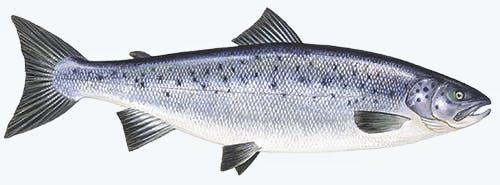Protein and Fat: Atlantic salmon require a diet rich in protein (35-45%) and fat (20-30%) to support their rapid growth and high-energy needs. These nutrients typically come from fish meal, fish oil, and increasingly from plant-based or algae-based alternatives.
Omega-3 Sources: The inclusion of omega-3 fatty acids, either from marine or algae sources, is crucial to ensure the salmon’s flesh quality and health benefits for consumers.
Vitamins and Minerals: Essential nutrients like vitamins A, D, and E, as well as minerals like phosphorus and selenium, are included to support growth, immune health, and bone development.
Sustainability: Feed innovations, such as the use of insect protein, soy protein concentrate, and microbial-based ingredients, are reducing reliance on wild fish stocks, making salmon farming more sustainable.

Atlantic salmon
Atlantic salmon (Salmo salar) is a cold-water, anadromous fish native to the North Atlantic Ocean. It is one of the most commercially important aquaculture species worldwide due to its rapid growth, high market demand, and premium nutritional value. It is predominantly farmed in countries like Norway, Chile, Scotland, and Canada. Atlantic salmon farming is a cornerstone of global aquaculture, meeting the high demand for this nutritious, versatile fish while continually innovating to ensure environmental and economic sustainability.
Feed programs
Configure the parameters below and download the data sheets you need for your species.Configurate parameters
Choose one or multiple feed sizes below
Choose a feed format below
Download data sheets
PerformanceGoodHigher
Select options to access data sheets.
Choose a size on the left hand side.Black soldier fly meal in feed for salmon
Austevoll Melaks and Aller Aqua have tested insect meal in feed for aquaculture with the collaboration of NMBU.